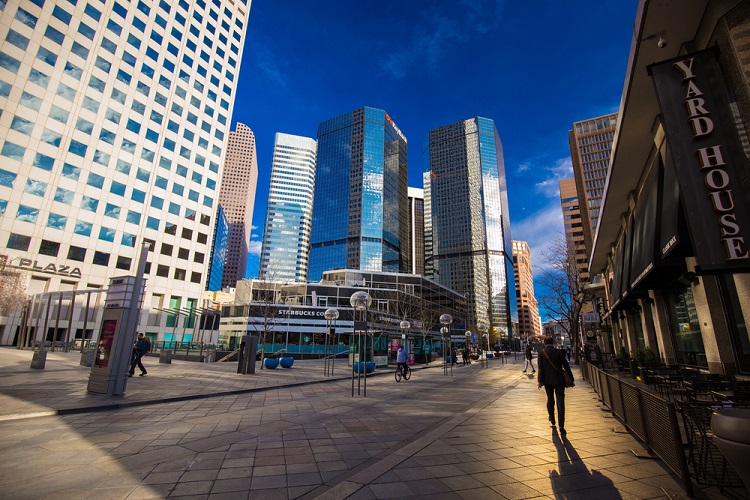The Downside of Denver's Rise as a Hub of Enterprise
In the shadow of Denver Startup Week, how prosperity brings challenges to Denver neighborhoods
Gabriel Go //October 8, 2019//


The Downside of Denver's Rise as a Hub of Enterprise
In the shadow of Denver Startup Week, how prosperity brings challenges to Denver neighborhoods
Gabriel Go //October 8, 2019//

Touted as one of the largest events of its kind, this year’s Denver Startup Week saw over 20,000 attendees from all over the country ̶ myself and a van full of Colorado State University journalism students included.
Our assignment was to cover the first day of Startup Week, attend presentations and make connections. As we drove back to Fort Collins, we passed by a shelter for the homeless. As we waited at the stop light, displaced Denverites crowded around the shelter’s entrance and sidewalk, all just five blocks away from Startup Week’s Arapahoe and 16th Street Mall venues. Startup Week is an indication of Denver’s strong commercial muscle, but the city’s rapid growth is accompanied and checked by the visible realities of gentrification and displacement.
Since 2012, Denver Startup Week has signaled the city’s ascension as a hub of enterprise, but this only describes a portion of Denver’s expansion since recovering from the 2008 recession. Denver is now the 12th most affordable city to launch startups and boasts an unemployment rate of 2.7% ̶ one of the nation’s lowest as of July 2019. But for Irene Aguilar, a former state senator now serving as the director of Denver’s Neighborhood Equity and Stabilizing Team ̶ a citywide task force which provides residents and small business owners in gentrifying zones with resources like financial coaches to social services ̶ Denver’s attractiveness for business is more than just good economics.
“What you saw (after 2008) was a city that was very much open for business … which for who knows what reason in particular, was very successful in attracting business,” Aguilar says, partially attributing this to recreational marijuana, the mountain scenery and the active Colorado lifestyle as incentives for the young, mostly millennial entrepreneurs who now make up at least 24% of Metro Denver’s population. Ultimately, one fact was assured: Denver had exceeded its expectations and capacity to accommodate a larger population.
“It was about 2013 when we started noticing we were getting more bang for our buck than perhaps anticipated,” Aguilar says.
Gentrification refers to a broad set of neighborhood phenomena, though Denver’s Office of Economic Development defines it as, “(The process that) occurs when a neighborhood has attractive qualities ̶ for example, location or historic architecture ̶ but remains relatively low value.”
Visibly, gentrification can also refer to the transformation vacant or low-income neighborhoods undergo to accommodate an influx of middle-class residents. Working-class streets bearing the red bricked-husks of defunct manufacturing plants and vintage homes give way to art districts and trendy establishments close to Downtown, and as the number of millennials moving into these districts rises, so does the cost of living for these neighborhoods’ longtime residents and their risk for displacement.
“When there is only so much product, the price is driven up and those who can pay stay, and those who can’t have to move,” Aguilar says. “If you think of the influx of young people making high tech salaries, they put a pressure on the housing market in undesirable areas.”
In addition to real estate costs, a 2006 study from the Office of Economic Development also cites wage stagnation as a factor, which millennials, too, aren’t exempt from. Although millennials typically have better access to home purchases than lower-income residents, rising home costs still outpace the state’s median income. “A single food preparation and serving worker would have to work 62 hours/week to live in Denver, at the hourly median wage of $8.96,” the study says.
Under Mayor Michael B. Hancock, the city has taken a series of initiatives to address displacement. In February, Hancock announced an increased hourly wage of $15 by 2021 for the city’s contractors and employees; in September, Hancock and City Councilwoman Robin Kneich announced legislation that would expand the $15 minimum wage to all of Denver’s workers, increasing to $13.80 by Jan.1, 2020 and $15.87 by 2021. The city will gather feedback on the proposal throughout October for consideration in November.
“We need to think about how much income inequality in the United States and how that is manifesting itself in issues like gentrification and displacement,” Aguilar says. “This is a symptom of a larger societal problem that people aren’t quite ready to deal with.”
 Gabriel Go is a senior journalism and political science student at Colorado State University, graduating in 2020. He has reported for CSU’s student newspaper, The Rocky Mountain Collegian, and served as the publication’s night editor between 2018 and 2019. Go is currently the editor-in-chief of College Avenue magazine, a quarterly student-run lifestyle magazine under the Rocky Mountain Student Media Corporation. Go participated in a partnership between the University and ColoradoBiz magazine that brought students from Fort Collins to Denver Startup Week 2019.
Gabriel Go is a senior journalism and political science student at Colorado State University, graduating in 2020. He has reported for CSU’s student newspaper, The Rocky Mountain Collegian, and served as the publication’s night editor between 2018 and 2019. Go is currently the editor-in-chief of College Avenue magazine, a quarterly student-run lifestyle magazine under the Rocky Mountain Student Media Corporation. Go participated in a partnership between the University and ColoradoBiz magazine that brought students from Fort Collins to Denver Startup Week 2019.
























